Yesterday (March 8), Kosovar women and men took over the main streets of the capital to once again mark International Women’s Day by demanding social and gender equality. Under the same “MARS’hojmë S’festojmë” (“MARCHing not celebrating”) motto as the previous two years’ activities, the feminist collective of the same name prepared a series of actions, including the now traditional march, as well as a call for a strike.
Hundreds of citizens gathered in Prishtina’s Zahir Pajaziti square, before embarking on a march across the city, stopping in front of the government building. Amid an energetic atmosphere, chants calling for equality and equal employment opportunities were heard, alongside statements decrying patriarchy, capitalism, homophobia and transphobia.
The chants became particularly vibrant and intense when marchers passed by three billboards that had been placed close to the Kosovo Police’s headquarters on Luan Haradinaj street. Two featured the names of the late Diana Kastrati and Zejnepe Bytyqi, both of whom were murdered by their husbands, while the third asked ‘How many more missed calls?’ in reference to the failure of authorities to protect the victims in time. The billboards were the work of the Haveit art collective, and were inspired by the Oscar nominated movie “Three Billboards Outside Ebbing, Missouri.”
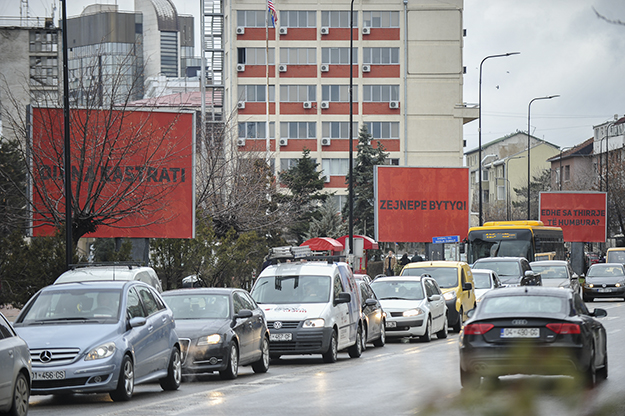
Prishtina based art collective ‘Haveit’ took the protest against gender based violence to the city’s billboards, referencing the name of two women murdered by their husbands and the authorities’ failure to protect them. Photo: Atdhe Mulla / K2.0.
A number of citizens also joined the International Women’s Strike, organized across the globe as part of ‘A Day Without Women’ — an effort to highlight economic inequality, as well as the under recognized unpaid work that women are often burdened with in addition to paid employment.
Yesterday’s women led activism, both in Prishtina and across the country, are part of a long lineage of protests in Kosovo on International Women’s Day stretching back decades. Here, K2.0 brings you some of the key events that have taken place on March 8 and helped shape the women’s rights activism we see today.
March 8, 1990
On March 8, 1990, a few hundred women, including members of the Women’s Association of the Democratic League of Kosovo (LDK) — the political party that led the nonviolent resistance to Serbian oppression during the ’90s — gathered at the Boro and Ramiz Youth Center in Prishtina. At a time which would later come to be known as just the beginnings of a decade of oppression under the Milosevic regime, the LDK Women’s Association publicly announced their separation from the Yugoslav Socialist Women’s League.
A 2008 book published by the Kosovar Gender Studies Centre, “History is Herstory too”, details the demonstration and includes the original call to protest issued by Luljeta Pula-Beqiri, head of the LDK Women’s Association. In it, Pula-Beqiri referenced the young people killed in student protests in Prishtina throughout the ’80s, as well as systemic police violence, and encouraged a boycott of any organized celebrations of March 8.
Despite the historic nature of the protest, the formation of the LDK Women’s Association just days before the demonstration was met with disappointment by some members of the women’s movement in Kosovo.
By the end of the ’80s many felt that, as well as participating in political activities, women needed to have a more unique voice, and there was a growing movement supporting the notion of creating an independent women’s association, separate from any political party.
As Safete Rogova is quoted as saying in “History is Herstory too”: “Women wanted to contribute independently from men and, at times, hold men accountable to meeting their needs as women, in addition to meeting the needs of the nation.”
But Rogova was to be disappointed. The majority of the women who had supported the notion of an independent organization went on to join LDK in the LDK Women’s Association — later known as the LDK Women’s Forum. Sevdije Ahmeti, who went on to lead the Center for the Protection of Women and Children, considered this moment as ‘the great betrayal.’ Ahmeti and Rogova remained among the very few women activists who didn’t join LDK.
For Safete’s sister, Igballe Rogova, the director of the Kosovo Women’s Network (KWN), — the sister act tackled illiteracy and repressive traditions with their Motrat Qiriazi (Qiriazi Sisters) organization throughout the ’90s — the defiance shown to joining LDK marks the birth of feminist movement in Kosovo. “I think that the first step was when they said ‘No’ to the Association,” Rogova told K2.0. “It was a message that said ‘we also have women’s issues,’ during the national movement.”
March 8, 1998
On International Women’s Day in 1998, around 15,000 Kosovar women protested in front of the American Center in Prishtina demanding that human rights violations in Kosovo urgently be addressed. Surrounded by a heavy police presence in Prishtina, every woman held aloft a white sheet. Similar protests were held in towns and cities across Kosovo.
“Protests around the world on International Women’s Day have targeted regimes that continue to deny equal rights,” read a BBC report on that day in 1998. “The biggest demonstration was held in the town of Pristina, capital of the Serbian province of Kosovo which has seen much recent violence.”
While activists and citizens were protesting peacefully in the capital of Kosovo, just a few kilometers away, hundreds of women and children were under threat from Serbian forces who were besieging the Drenica region.
The beginning of 1998 had seen the first massacres by Serbian forces against Kosovar Albanian civilians in Drenica’s villages, atrocities that are often viewed as marking the start of the war in Kosovo. Women protesters, well aware that women and children in Kosovo were being subjected to assaults and murder, appealed to the international community to intervene.
“We held white sheets, because there was nothing more to say,” Sociologist Linda Gusia remembers being told by Sevdije Ahmeti, the late prominent activist, who ran the Center for the Protection of Women and Children at the time. Gusia explains that by that stage, women activists were the ones most frequently breaking the the passive resistance and had held so many protests over the numerous human rights violations occurring in Kosovo in the ’90s that by March 1998, all that was left to say was a white sheet.
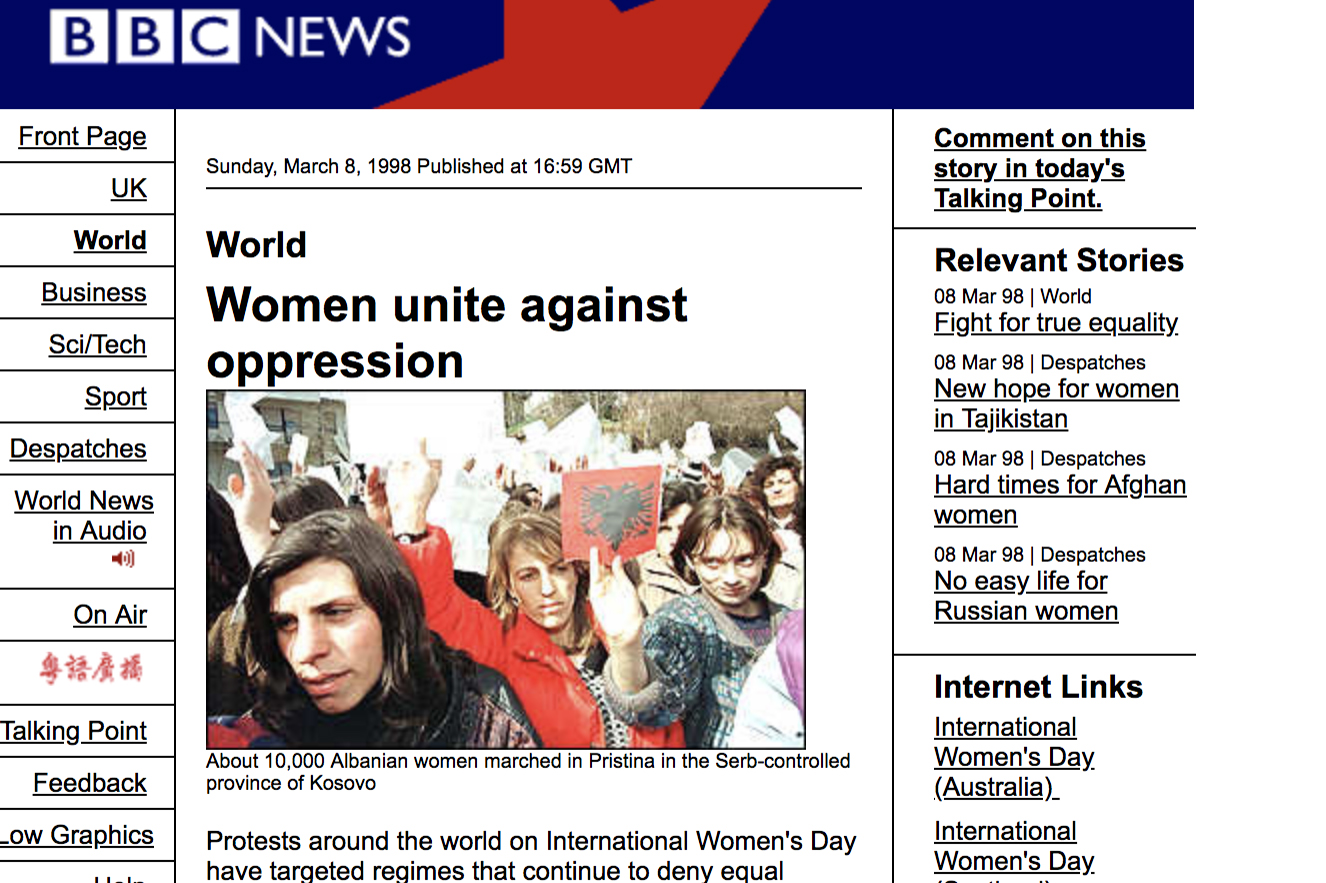
The BBC described the March 8 protest in Prishtina as the biggest on that year’s International Women’s Day. Photo: Screenshot.
Just a few days after the March 8 protest, the Center for the Protection of Women and Children initiated the most iconic women’s protest held in Kosovo to date. On March 16, 1998 they were joined by various women’s activism organizations and the LDK Women’s Forum in the famous protest under the motto: “Bread for Drenica Women and Children.”
Several thousand women walked through the streets of Prishtina, holding loaves of bread in their hands, with the intention of walking to Drenica. The march, which sent a message to the international community and humanitarian organizations that women and children from Drenica were under perilous threat, both from starvation and more directly from Serbian forces, was stopped by the Serbian police.
“During the ’90s, demands for equality were interlinked with freedom, nation and state,” explains Eli Gashi, co-founder of Alter Habitus, Institute for Studies in Society and Culture. “But the movement of the ’90s enabled us to further push the agenda and then discuss other elements that make the feminist movement even more sustainable.”
March 8, 2000
March 8, 2000 saw one of the first protests after the Kosovo war. It was organized by the Union of Kosovo Women’s NGOs (an informal coalition, which was formalized as the KWN in 2003) and took place in front of the National Theater in Prishtina.
Women held enlarged photographs of their missing family members and distributed pamphlets to passers-by, which read ‘Kosovo cannot be free if Serbia does not release all Albanian protesters.’ Photos of missing persons were placed on on the fence that encircles what is now the Kosovo Assembly and government building.

After the photos left as part of 2000’s demonstration were removed in 2013, activists replaced them on March 8, 2014. Photo courtesy of the Kosovo Women’s Network.
In the following days, women activists continued to protest and maintained a hunger strike in order to raise awareness about missing persons, as well as demanding the release of Albanian political prisoners held in Serbian prisons.
At the end of the war in 1999, it was estimated that more than 5,000 people were missing. That number has decreased over the years, in part due to the steady uncovering of mass graves — bodies of hundreds of Kosovar Albanians were transferred to Serbia by Serbian forces and buried in mass graves as a way of hiding the evidence of atrocities.
The photos of the missing were removed in 2013, with politicians promising that a memorial will be dedicated to missing persons. When the promise went unfulfilled, KWN were among those calling for the government to make efforts to address the issue, and made missing persons the focus of 2014’s March 8 protest. After the march, the photos reappeared on the fence.
Around 1,665 persons are still considered missing.
March 8, 2006
In early 2006, preparations were being made for negotiations regarding the final status of Kosovo — UN backed talks which led to Kosovo’s Independence in 2008. The failure to address women’s needs and respond to their voices during the negotiation process caused outrage among women’s rights activists.
KWN organized a March 8 protest demanding the participation of women during the negotiations. It became the first protest that saw the signature moto “We don’t want flowers,” which appeared at annual protests in following years. “We don’t want flowers, we want power,” activists called out in the protest.
“The negotiating team was created and we saw no women there so we started the Coalition of Women for Peace,” Rogova recalls. “KWN and the Women in Black network in Serbia took to the street at the same time in Prishtina and Belgrade.”
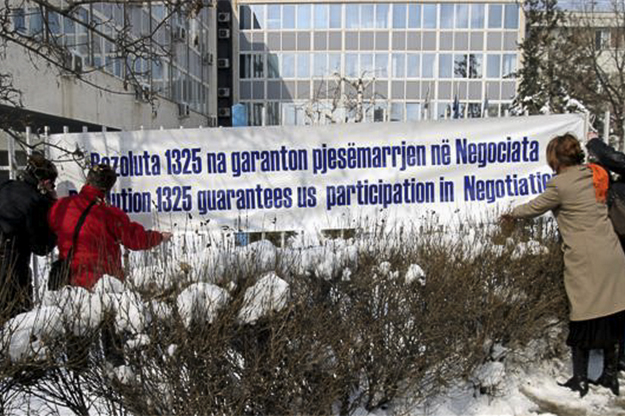
In 2006, activists called for women to participate in the negotiations regarding the final status of Kosovo, in line with UN Security Council Resolution 1325. Photo Courtesy of Kosovo Women’s Network.
During the peace building process, women’s rights organizations were very vocal in their demand to apply UN Security Council Resolution 1325, which calls for an adoption of a gender perspective to consider the particular needs of women and girls during post-conflict reconstruction, and increase the role of women in peace and security efforts.
“UNMIK has a forgetfulness on many levels when it comes to the history before their intervention and its establishment,” lecturer at the University of Prishtina, Nita Luci, told K2.0 earlier this year. “Women activists’ protests and their approach to the highest ranks of UNMIK shows that they didn’t allow the history [of their engagement] to be deleted.”
March 8, 2012
By 2012, the recurring flower motto had evolved into “We don’t want flowers, we want justice for women and girls raped during the war,” with KWN organizing a March 8 protest calling for justice for survivors of sexual violence. On the same day, women activists sent a letter to Xavier Bout de Marnhac, the then head of EULEX, asking that special attention be paid to investigations into gender based violence during Kosovo war.
“This wasn’t a spur-of-the-moment thing. It was a request from survivors,” Rogova recalls. “Immediately after the war they had talked about their experience, hundreds gave their testimony to UNMIK and then they got isolated. They didn’t want to speak anymore. They were stigmatized.”
Rogova says that the demand was coordinated together with the Group of Women Deputies of the Kosovo Assembly, who the next day (March 9, 2012) raised the issue of survivors of sexual violence at the Assembly. A Human Rights Watch report from 2000 identified that during the war, “rape and other forms of sexual violence were used as weapons of war and instruments of systematic ‘ethnic cleansing.’”
It was only in March 2014 that the right of survivors to reparations, predominantly in the form of monthly monetary compensation, was recognized in amendments to the existing law that covers the status of victims of war.
It took until February this year for Kosovar survivors of wartime sexual violence to be able to start applying to the verification process, which should pave the way to long awaited recognition and reparations for the harm they received during the Kosovo war.
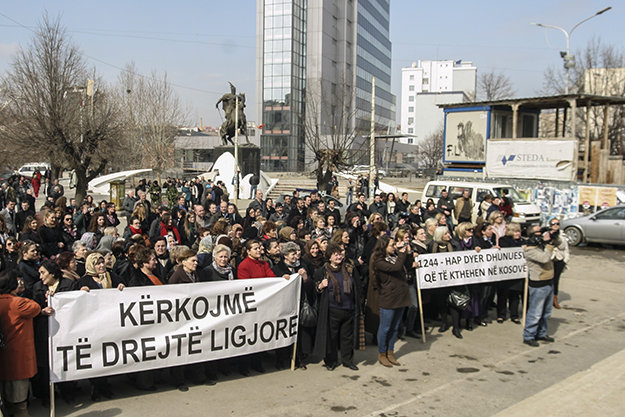
A number of KWN protests helped bring previously unspoken about issues into public discourse, including in 2006 when activists demanded that domestic violence be covered in Kosovo’s legislation. Photo courtesy of Kosovo Women’s Network.
Rogova believes the 2012 protest was one of a number organized by KWN that helped bring difficult subjects into public discussion. “We broke three taboos,” she tells K2.0. “The first was domestic violence, which was always treated as a private matter, and we broke it and made it public. The second one is breast cancer because it was never publicly discussed. And the third one is sexual violence during the war.”
The organization first highlighted the issue of domestic violence through public demonstration on March 8, 2004, when activists held a protest demanding that the protection against domestic violence to be addressed by the laws of the state. “We want legislation!,” was one of the key slogans of the protest organized by KWN.
Even after the creation of the official Law on Protection against Domestic Violence, the failure of its implementation saw gender based violence become topic of many future protests.
In regard to breast cancer, on March 8, 2007, KWN together with the Kosovar Center for Fighting Breast Cancer organized a petition in order to raise awareness about the spread disease.
March 8, 2016
The 2016 march was regarded as special, and even historic, for many activists as it was the first time protests were spearheaded by the MARS’hojmë S’festojmë Collective, which was made up of both women and men working together, and included LGBTI individuals and members of different ethnic groups.
Rogova considers that the activities in 2016, which dispersed operations outside of the walls of KWN gave a completely new shape to women led activism in Kosovo. “The participation wasn’t very satisfactory in the protests organized by KWN and the collective is a victory of everyone,” she says. “Seeing all these young people renewed me and gave me new hope. With just KWN, it was hard for different activists to come into the light.”
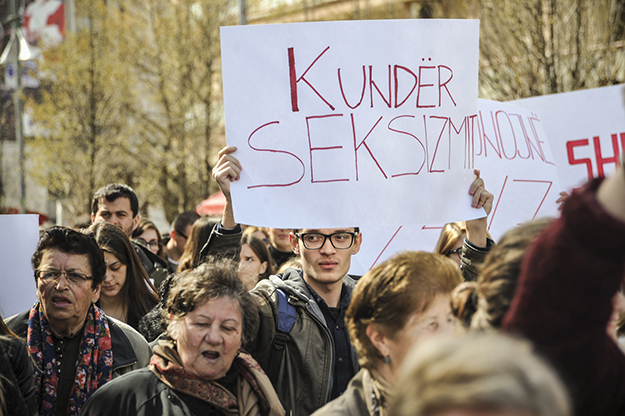
Since 2016, the MARS’hojmë S’festojmë Collective have organized March 8 activities in Prishtina, which has seen a wider participation and a more diverse set of citizens joining the protests. Photo Atdhe Mulla / K2.0.
The continuing calls of the collective are for employment without exploitation, health insurance, non-discriminative work for all and a firm defiance to sexism, homophobia, transphobia and racism.
“The collective has grown to become a social movement, which includes more diverse citizens, ready to take the streets to fight gender inequality,” adds Iliriana Banjska a KWN employee, and one of the prominent activists of the collective.
The creation of the collective has also seen a significant representation of feminist men, both behind the scenes and on the streets. “It has never been clearer that [feminism] benefits everyone: men, women and every other gender that human beings identify as,” explains Erblin Ajdini, a gender mainstreaming expert and member of the MARS’hojmë S’festojmë collective.
“Because of my work on gender mainstreaming and the knowledge I get every day from other feminists and even feminist publications, I feel like I have to give back to causes like the 8th of March,” Ajdini continues. “It’s an action not about celebration, but one in which we highlight the gender inequalities that women face.”
March 8, 2017
The following year, the MARS’hojmë S’festojmë Collective took to the streets to raise the issue of gender and economic equality. “I don’t want flowers, I want a job contract,” “Protection at work,” and “Raise the minimum wage,” were some of the prominent slogans that appeared.
It was the first year that saw the collective tie their actions to global initiatives. 2017 featured a worldwide theme of work spearheaded by UN Women under the title ‘Women in the Changing World of Work: Planet 50-50 by 2030.
Gusia argues that economic rights being raised worldwide helped put the focus of the effects of economic inequality on gender inequality. “We have a comeback of feminist movements and empowerment,” she tells K2.0. “There is also now a theoretical link between capitalism and patriarchy. The idea of feminism today is that it is linked with other identities. It is about intersectionality. The system of inequalities is not just built of the idea of the gender, but is linked with other aspects, particularly the economic one.”
2017 also saw the beginnings of the decentralization of women led activism on March 8, with FEMaktiv, a group of young feminist activists in Prizren, protesting against public and political discourse in the city, which they described as exclusionary towards women.
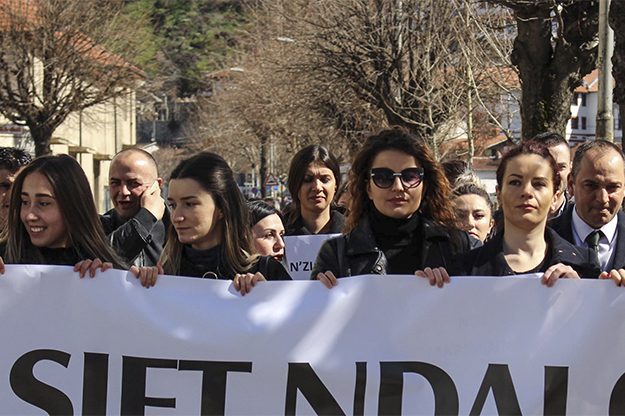
Women led activism has decentralized out of Prishtina in recent years, with actions taking place in other Kosovar cities, including a ‘march in black’ in Prizren in 2018. Photo courtesy of FEMaktiv Prizren.
Decentralization peaked this year, with marches also taking place in Ferizaj and Malisheva, alongside those in Prishtina and Prizren. Activists in Malisheva protested against child marriages, while FEMaktiv marched under the slogan ‘N’zi Marshojme’ (Marching in Black) in the name of all women that lost their lives as a result of violence committed towards them.
“The patriarchal system is so rooted in society, that even violence towards women has started to be normalized,” Adelina Hasani, a FEMaktiv activist told K2.0. “This phenomenon needs to be fought in a societal way, thus state policies need to change in this direction. The change of state politics is necessary for the prevention of violence towards women.”
Eli Gashi says that women’s movement has grown over the years in terms of the number of activists supporting the cause of equality, but also in content, with a new critique towards the establishment.
“For many years the women’s movement dealt mainly with women’s representation in society, with an emphasis on political representation,” Gashi says. “But the request for representation just in terms of numbers does not necessarily enable the social equality which is aimed for by the feminist movement. If we look at the last two protests organized on March 8 from the MARS’hojmë S’festojmë Collective, social injustice is central to the collective’s requests.”K
Feature image: Atdhe Mulla / K2.0.
Edited by Jack Robinson.

